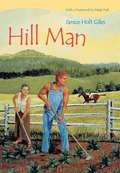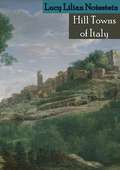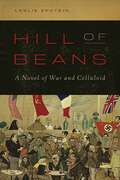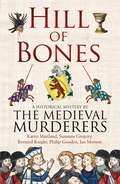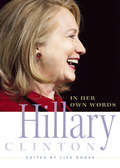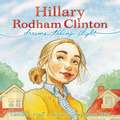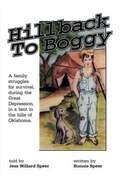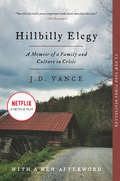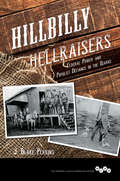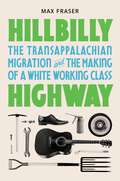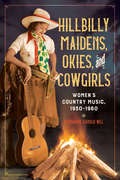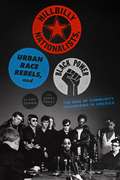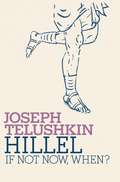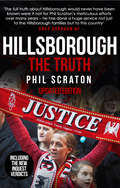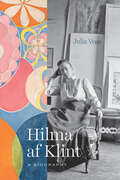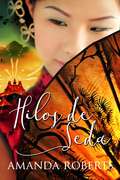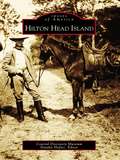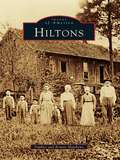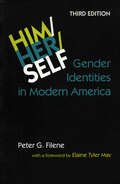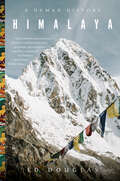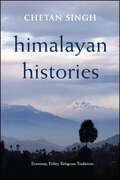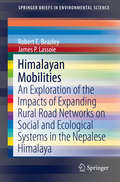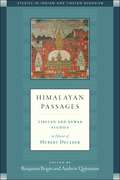- Table View
- List View
Hill Man
by Janice Holt GilesRady Cromwell is a young man who has drive and determination that will see him through his life long. At age 12 he wants a gun a hunting dog, and a guitar. At 17 he has his eyes on a good farm and the widow who owns it. Though the book will take many twists and turns, he in the end is striving after something more.
Hill Towns of Italy
by Lucy Lilian NotesteinLucy Lilian Notestein’s Hill Towns of Italy is a lyrical and evocative exploration of Italy’s picturesque hilltop villages, capturing the charm, history, and cultural richness of these timeless landscapes. With keen observation and poetic prose, Notestein takes readers on a journey through the cobbled streets, ancient walls, and vibrant traditions that define these remarkable towns.From Tuscany’s rolling hills to the rugged regions of Umbria and beyond, the book offers vivid descriptions of the architecture, art, and daily life that make each town unique. Notestein weaves together historical anecdotes, local legends, and personal impressions to create an intimate portrait of these enchanting places. Readers will find themselves immersed in the beauty of medieval fortresses, sun-drenched piazzas, and the enduring rhythms of rural Italian life.More than a travelogue, Hill Towns of Italy delves into the cultural and historical significance of these towns, highlighting their role as centers of art, religion, and community over the centuries. Notestein’s deep appreciation for the region’s heritage and her ability to bring its people and places to life make this book a treasure for both armchair travelers and seasoned adventurers.Whether you are drawn to Italy’s storied past, its artistic treasures, or the simple beauty of its landscapes, Hill Towns of Italy offers a rich and rewarding glimpse into one of the world’s most captivating regions. This timeless work is a must-read for lovers of history, art, and travel.
Hill of Beans: A Novel of War and Celluloid
by Leslie EpsteinThe film Casablanca opens with the words, &“With the coming of the Second World War, many eyes in imprisoned Europe turned hopefully, or desperately, toward the freedom of the Americas.&” Leslie Epstein&’s Hill of Beans is the story of how one nation, one industry, and in particular one man responded to that desperate hope. That man is Jack Warner. His impossible goal is to make world events—most importantly, the invasion of North Africa by British and American forces in 1942—coincide with the release of his new film about a group of refugees marooned in Morocco. Arrayed against him are Stalin and Hitler, as well as Josef Goebbels, Franklin Roosevelt, a powerful gossip columnist, and above all a beautiful young woman with a terrible secret. His only weapons are his hutzpah and his heroism as he struggles to bring cinema and city, conflict and conference together in an epic command performance.Hill of Beans is the novel that Leslie Epstein—the son and nephew of Philip and Julius Epstein, the screenwriters of Casablanca—was born to write.
Hill of Bones (Medieval Murderers #7)
by The Medieval MurderersCerdic, a young boy who has the ability to see into the future, has a mysterious treasure in his possession. A blind old woman once gave him a miniature knife with an ivory bear hilt - the symbol of King Arthur - and told him that when the time comes he will know what he has to do with it. But when he and his brother, Baradoc, are enlisted into King Arthur's army, he finds that trouble seems to follow him wherever he goes. When Baradoc dies fighting with King Arthur in an ambush of the Saxons on Solsbury Hill, Cerdic buries the dagger in the side of the hill as a personal tribute to his brother. Throughout history, Solsbury Hill continues to be the scene of murder, theft and the search for buried treasure. Religion, politics and the spirit of King Arthur reign over the region, wreaking havoc and leaving a trail of corpses and treasure buried in the hill as an indication of its turbulent past.
Hillary Clinton in Her Own Words
by Lisa RogakLisa Rogak, author of the New York Times bestseller Barack Obama in His Own Words, now brings readers Hillary Clinton in Her Own Words-quotations from the former First Lady, Senator from New York, and Secretary of State that go beyond politics. Topics range from leadership to life in the White House, and include her opinions on family, aging, public scrutiny, religion, motherhood, and marriage:"If I want to knock a story off the front page, I just change my hairstyle." -June 4, 1995"I have a million ideas. The country can't afford them all."-October 11, 2007"We will never build enough prisons to end our crime problem." -February 7, 1996"Being gay is not a western invention. It is a human reality."-December 6, 2011Spanning more than two decades, this provocative collection is a must for all Hillary fans.
Hillary Rodham Clinton
by Kathleen Krull Amy June BatesWhen Hillary was young, she wanted to be an astronaut, to soar as high as the stars above. She kept reaching up and up as she grew. There were people who told her no. But she didn't listen to them. There were people who didn't think she could do it. But she believed in herself. And Hillary has been making history ever since. This is the inspiring story of a girl with dreams as big as the open sky.
Hillback to Boggy
by Bonnie S. Speer Jess W. SpeerJess and Bonnie Speer have spun one of the best tales concerning Oklahoma history since The Grapes of Wrath. The reader will laugh some and cry some with these memorable characters. Hillback to Boggy is a story of one of Oklahoma's most trying times, the Depression years, and of a family that struggled for survival in a tent in the hill country of Hughes County. Papa tried to live by the Bible, but when he did people took advantage of him. "You can make peace with the birds and animals, but you can't with people, he said "Some of them are just a natural-born son-of-a-bitch."
Hillbilly Elegy: A Memoir of a Family and Culture in Crisis
by J. D. VanceHillbilly Elegy recounts J.D. Vance's powerful origin story...From a former marine and Yale Law School graduate now serving as a U.S. Senator from Ohio and the Republican Vice Presidential candidate for the 2024 election, an incisive account of growing up in a poor Rust Belt town that offers a broader, probing look at the struggles of America's white working class.THE #1 NEW YORK TIMES BESTSELLER"You will not read a more important book about America this year."—The Economist"A riveting book."—The Wall Street Journal"Essential reading."—David Brooks, New York TimesHillbilly Elegy is a passionate and personal analysis of a culture in crisis—that of white working-class Americans. The disintegration of this group, a process that has been slowly occurring now for more than forty years, has been reported with growing frequency and alarm, but has never before been written about as searingly from the inside. J. D. Vance tells the true story of what a social, regional, and class decline feels like when you were born with it hung around your neck.The Vance family story begins hopefully in postwar America. J. D.'s grandparents were "dirt poor and in love," and moved north from Kentucky's Appalachia region to Ohio in the hopes of escaping the dreadful poverty around them. They raised a middle-class family, and eventually one of their grandchildren would graduate from Yale Law School, a conventional marker of success in achieving generational upward mobility. But as the family saga of Hillbilly Elegy plays out, we learn that J.D.'s grandparents, aunt, uncle, and, most of all, his mother struggled profoundly with the demands of their new middle-class life, never fully escaping the legacy of abuse, alcoholism, poverty, and trauma so characteristic of their part of America. With piercing honesty, Vance shows how he himself still carries around the demons of his chaotic family history.A deeply moving memoir, with its share of humor and vividly colorful figures, Hillbilly Elegy is the story of how upward mobility really feels. And it is an urgent and troubling meditation on the loss of the American dream for a large segment of this country.
Hillbilly Hellraisers: Federal Power and Populist Defiance in the Ozarks
by J. Blake Perkins J PerkinsJ. Blake Perkins searches for the roots of rural defiance in the Ozarks--and discovers how it changed over time. Eschewing generalities, Perkins focuses on the experiences and attitudes of rural people themselves as they interacted with government in the late nineteenth and twentieth centuries. He uncovers the reasons local disputes and uneven access to government power fostered markedly different reactions by hill people as time went by. Resistance in the earlier period sprang from upland small farmers' conflicts with capitalist elites who held the local levers of federal power. But as industry and agribusiness displaced family farms after World War II, a conservative cohort of town business elites, local political officials, and Midwestern immigrants arose from the region's new low-wage, union-averse economy. As Perkins argues, this modern anti-government conservatism bore little resemblance to the populist backcountry populism of an earlier age but had much in common with the movement elsewhere.
Hillbilly Highway: The Transappalachian Migration and the Making of a White Working Class (Politics and Society in Modern America #157)
by Max Fraser&“The best book to explain the world J. D. Vance came from is Max Fraser&’s Hillbilly Highway.&”—Jessica Wilkerson, author of To Live Here, You Have to Fight: How Women Led Appalachian Movements for Social JusticeOver the first two-thirds of the twentieth century, as many as eight million whites left the economically depressed southern countryside and migrated to the booming factory towns and cities of the industrial Midwest in search of work. The "hillbilly highway" was one of the largest internal relocations of poor and working people in American history, yet it has largely escaped close study by historians. In Hillbilly Highway, Max Fraser recovers the long-overlooked story of this massive demographic event and reveals how it has profoundly influenced American history and culture—from the modern industrial labor movement and the postwar urban crisis to the rise of today&’s white working-class conservatives.The book draws on a diverse range of sources—from government reports, industry archives, and union records to novels, memoirs, oral histories, and country music—to narrate the distinctive class experience that unfolded across the Transappalachian migration during these critical decades. As the migration became a terrain of both social advancement and marginalization, it knit together white working-class communities across the Upper South and the Midwest—bringing into being a new cultural region that remains a contested battleground in American politics to the present.The compelling story of an important and neglected chapter in American history, Hillbilly Highway upends conventional wisdom about the enduring political and cultural consequences of the great migration of white southerners in the twentieth century.
Hillbilly Maidens, Okies, and Cowgirls: Women’s Country Music, 1930-1960 (Music in American Life)
by Stephanie Vander WelFrom the 1930s to the 1960s, the booming popularity of country music threw a spotlight on a new generation of innovative women artists. These individuals blazed trails as singers, musicians, and performers even as the industry hemmed in their potential popularity with labels like woman hillbilly, singing cowgirl, and honky-tonk angel. Stephanie Vander Wel looks at the careers of artists like Patsy Montana, Rose Maddox, and Kitty Wells against the backdrop of country music's golden age. Analyzing recordings and appearances on radio, film, and television, she connects performances to real and imagined places and examines how the music sparked new ways for women listeners to imagine the open range, the honky-tonk, and the home. The music also captured the tensions felt by women facing geographic disruption and economic uncertainty. While classic songs and heartfelt performances might ease anxieties, the subject matter underlined women's ambivalent relationships to industrialism, middle-class security, and established notions of femininity.
Hillbilly Nationalists, Urban Race Rebels, and Black Power: Community Organizing in Radical Times
by James Tracy Amy SonnieTHE STORY OF SOME OF THE MOST IMPORTANT AND LITTLE-KNOWN ACTIVISTS OF THE 1960s, IN A DEEPLY SOURCED NARRATIVE HISTORY The historians of the late 1960s have emphasized the work of a group of white college activistss who courageously took to the streets to protest the war in Vietnam and continuing racial inequality. Poor and working-class whites have tended to be painted as spectators, reactionaries, and, even, racists. Most Americans, the story goes, just watched the political movements of the sixties go by. James Tracy and Amy Sonnie, who have been interviewing activists from the era for nearly ten years, reject this old narrative. They show that poor and working-class radicals, inspired by the Civil Rights movement, the Black Panthers, and progressive populism, started to organize significant political struggles against racism and inequality during the 1960s and 1970s. Among these groups: > JOIN Community Union brought together southern migrants, student radicals, and welfare recipients in Chicago to fight for housing, health, and welfare . . . > The Young Patriots Organization and Rising Up Angry organized self-identified hillbillies, Chicago greasers, Vietnam vets, and young feminists into a legendary "Rainbow Coalition" with Black and Puerto Rican activists . . . > In Philadelphia, the October 4th Organization united residents of industrial Kensington against big business, war, and a repressive police force . . . > In the Bronx, White Lightning occupied hospitals and built coalitions with doctors to fight for the rights of drug addicts and the poor. Exploring an untold history of the New Left, the book shows how these groups helped to redefine community organizing--and transforms the way we think about a pivotal moment in U.S. history.From the Trade Paperback edition.
Hillel: If Not Now, When?
by Joseph Telushkin"What is hateful unto you, do not do unto your neighbor. That is the whole Torah, all the rest is commentary. Now, go and study." This is the most famous teaching of Hillel, one of the greatest rabbis of the Talmudic era. What makes it so extraordinary is that it was offered to a gentile seeking conversion. Joseph Telushkin feels that this Talmudic story has great relevance for us today. At a time when religiosity is equated with ritual observance alone, when few Jews seem concerned with bringing Jewish teachings into the world, and when more than 40 percent of Jews intermarry, Judaism is in need of more of the openness that Hillel possessed two thousand years ago. Hillel's teachings, stories, and legal rulings can be found throughout the Talmud; many of them share his emphasis on ethical and moral living as an essential element in Jewish religious practice, including his citing the concept of tikkun olam repairing the world) as a basis for modifying Jewish law. Perhaps the most prominent rabbi and teacher in the Land of Israel during the reign of Herod, Hillel may well have influenced Jesus, his junior by several decades. In a provocative analysis of both Judaism and Christianity, Telushkin reveals why Hillel's teachings about ethics as God's central demand and his willingness to encourage the process of conversion began to be ignored in favor of the stricter and less inclusive teachings of his rabbinic adversary, Shammai. Here is a bold new look at an iconic religious leader.
Hillsborough - The Truth: The Truth
by Professor Phil ScratonThis is the definitive, unique account of the disaster in which 96 men, women and children were killed, hundreds injured and thousands traumatised. It details the appalling treatment endured by the bereaved and survivors in the immediate aftermath, the inhumanity of the identification process and the vilification of fans in the national and international media.In 2012, Phil Scraton was primary author of the ground-breaking report published by the Hillsborough Independent Panel following its new research into thousands of documents disclosed by all agencies involved. Against a backdrop of almost three decades of persistent struggle by bereaved families and survivors, in this new edition he reflects on the Panel’s in-depth work, its revelatory findings and their unprecedented impact – an unreserved apology from the Prime Minister; new criminal investigations; the Independent Police Complaints Commission’s largest-ever inquiry; the quashing of 96 inquest verdicts; a review of all health and pathology policies. Paving the way for truth recovery and institutional accountability in other controversial cases, he details the process and considers the impact of the longest ever inquests, from the preliminary hearings to their comprehensive, devastating verdicts.Powerful, disturbing and harrowing, Hillsborough: The Truth exposes the institutional complacency that led to the unlawful killing of the 96, revealing how the interests of ordinary people are marginalised when those in authority sacrifice truth and accountability to protect their reputations.
Hilma af Klint: A Biography
by Julia VossA highly anticipated biography of the enigmatic and popular Swedish painter. The Swedish painter Hilma af Klint (1862–1944) was forty-four years old when she broke with the academic tradition in which she had been trained to produce a body of radical, abstract works the likes of which had never been seen before. Today, it is widely accepted that af Klint was one of the earliest abstract academic painters in Europe. But this is only part of her story. Not only was she a working female artist, she was also an avowed clairvoyant and mystic. Like many of the artists at the turn of the twentieth century who developed some version of abstract painting, af Klint studied Theosophy, which holds that science, art, and religion are all reflections of an underlying life-form that can be harnessed through meditation, study, and experimentation. Well before Kandinsky, Mondrian, and Malevich declared themselves the inventors of abstraction, af Klint was working in a nonrepresentational mode, producing a powerful visual language that continues to speak to audiences today. The exhibition of her work in 2018 at the Guggenheim Museum in New York City attracted more than 600,000 visitors, making it the most-attended show in the history of the institution. Despite her enormous popularity, there has not yet been a biography of af Klint—until now. Inspired by her first encounter with the artist’s work in 2008, Julia Voss set out to learn Swedish and research af Klint’s life—not only who the artist was but what drove and inspired her. The result is a fascinating biography of an artist who is as great as she is enigmatic.
Hilma af Klint: A Biography
by Julia VossA highly anticipated biography of the enigmatic and popular Swedish painter. The Swedish painter Hilma af Klint (1862–1944) was forty-four years old when she broke with the academic tradition in which she had been trained to produce a body of radical, abstract works the likes of which had never been seen before. Today, it is widely accepted that af Klint was one of the earliest abstract academic painters in Europe. But this is only part of her story. Not only was she a working female artist, she was also an avowed clairvoyant and mystic. Like many of the artists at the turn of the twentieth century who developed some version of abstract painting, af Klint studied Theosophy, which holds that science, art, and religion are all reflections of an underlying life-form that can be harnessed through meditation, study, and experimentation. Well before Kandinsky, Mondrian, and Malevich declared themselves the inventors of abstraction, af Klint was working in a nonrepresentational mode, producing a powerful visual language that continues to speak to audiences today. The exhibition of her work in 2018 at the Guggenheim Museum in New York City attracted more than 600,000 visitors, making it the most-attended show in the history of the institution. Despite her enormous popularity, there has not yet been a biography of af Klint—until now. Inspired by her first encounter with the artist’s work in 2008, Julia Voss set out to learn Swedish and research af Klint’s life—not only who the artist was but what drove and inspired her. The result is a fascinating biography of an artist who is as great as she is enigmatic.
Hilos de seda
by Amanda RobertsCuando era niña, pensé que mi destino era vivir y morir en las orillas del río Xiangjiang, como lo había hecho mi familia durante generaciones. Nunca imaginé que mi vida me llevaría a la Ciudad Prohibida y al tribunal de la última Emperatriz de China. Nacida en medio de la nada, Yaqian, una pequeña niña bordadora de la provincia de Hunan, encuentra su camino hacia la corte imperial, un lugar de intriga, deseo y traición. Desde la cama de un Emperador, el corazón de un Príncipe y el lado derecho de una Emperatriz, Yaqian se abre paso a través de las décadas más turbulentas de la historia de China y es testigo de la caída de la Dinastía Qing. A los fans de Amy Tan, Lisa See, Anchee Min y Pearl S. Buck les encantará esta novela de debut de Amanda Roberts. Esta novela ricamente descriptiva y minuciosamente investigada da vida a la opulencia de Qing Court mientras la vida de Yaqian y la emperatriz Cixi se entrelazan durante seis décadas.
Hilton Head Island (Images of America)
by Coastal Discovery Museum Natalie HefterHilton Head Island, a celebrated resort community with a colorful and intriguing past, is one of South Carolina's premier tourist destinations. Its scenery and leisure industry attract more than 1.5 million visitors each year to play golf, relax on the beaches, or just to soak up the atmosphere. Before the fairways and hotels ever arrived on the scene, the island already had a long and interesting history dating back as far as 10,000 years ago, when Native Americans first began to visit the area. In Hilton Head Island, Natalie Hefter and the Coastal Discovery Museum revisit this history, charting the area's development from its first plantation in 1717, through the boom years of shipbuilding and Sea Island cotton to the Civil War. In over 200 vintagephotographs, the authors document the impact of the Union occupation, the establishment of Mitchelville (the island's "contraband" and Freedmen community), the dramatic effects of the first bridge to the island, and the development of the tourist industry that now typifies Hilton Head.
Hiltons
by Ronnie Matthews Daphne MatthewsHiltons is located in the southwest corner of Virginia and was named for the Reverend Samuel Hilton, who moved to the region from North Carolina in 1795. In the 1880s, Hiltons became a vital link for goods being transported both to and from the region when the railroad was constructed from Bristol to Appalachia. U.S. Highway 58 winds through Hiltons to Virginia Beach, providing many miles of scenic travel on what was, for many years, an important transportation route. The Hiltons area is blessed with natural beauty, including the scenic Clinch Mountains, a part of the Appalachian chain, and the lazy flowing north fork of the Holston River. Hiltons is home to the world-renowned Carter family of country music fame and is the location of the Carter Family Museum and Fold, which continues to provide old-time country music entertainment.
Him/Her/Self: Gender Identities in Modern America
by Peter G. FileneWhen first published in 1975, Him/Her/Self was a pathbreaking book. At a time when scholars were just beginning to explore women's history, Peter Filene expanded his inquiry to include both both genders. He was the first to claim the men, too, had a history grounded in gendered experience. Since then much has changed, not only in the lives and attitudes of American men and women, but in the ways that historians think about gender. But Him/Her/Self remains the only book that analyzes the interactions between American men and women comprehensively during the past century.In this third edition, Filene brings his concise and forceful analysis of 20th-century gender history up to the present. He describes the new men's movements of the 1980s and 1990s, ranging from pro-feminist to anti-feminist. He expands his discussion of the gay and lesbian experience, especially in the years since AIDS. He assesses the women's movement, weighing both its achievements and the antifeminist reactions of the past quarter-century. Finally, he enlarges the conceptual scope of the book, focusing not only on social roles of men and women but also on their dynamic sense of identity—of self in historical time."When Him/Her/Self first appeared, women's history was in its infancy. Gender as a category of analysis was barely a glow on the scholarly horizon, and the idea that manhood was a topic of historical investigation was practically unimagined. In that early dawn of feminist scholarship, Peter Filene's pioneering work was a godsend. It was essential reading for both undergraduate and graduate students eager to understand the workings of gender in history and desperate for models of scholarship that broke the mold of 'traditional' historical writing. Peter Filene's path breaking study did both."—Elaine Tyler May, from the Foreword
Himalay No Pravas
by Kakasaheb Kalelkarપ્રવાસી જેમ જેમ પ્રવાસ કરતો જાય છે તેમ તેમ તે કુનેહ કેળવે છે; ધીરજ અને ઉદારતા કેળવે છે; અને અંતે સારામાં સારો સમાજશાસ્ત્રી બને છે. પ્રવાસ એટલે અગવડો વેઠવાની બાદશાહી ઢબ. મુસાફરીમાં અગવડો આવવાથી માણસને એમ નથી થતું કે આપણા દારિદ્રયનું એ એક પ્રતીક છે. એને થાય છે કે સૂઝશક્તિ કેળવવાની આ એક તક આપણને મળી છે. એક રીતે જોતાં પ્રવાસ એ વ્યક્તિત્વના વિકાસનું સાધન છે; જ્યારે બીજી રીતે જોતાં એ દેશભક્તિનો એક અનુભવ-તરબોળ પ્રકાર છે. જેટલો દેશ આપણે જોયો, તપાસ્યો, પોતાનો કર્યો તેટલા દેશ પ્રત્યે આપણી વિશિષ્ટ લાગણી કેળવાય છે, એની સાથે આત્મીયતા બંધાય છે, એને વિશે અભિમાન અથવા ભક્તિ પેદા થાય છે, આપણે એના ભક્ત બની જઈએ છીએ. કોઈ પણ પ્રાંતની મુસાફરી કરી આવ્યા પછી અખબારોમાં વંચાતા ત્યાંના સમાચારો પ્રત્યે આપણી કેટલી બધી આસ્થા બંધાય છે!
Himalaya: A Human History
by Ed DouglasA magisterial history of the Himalaya: an epic story of peoples, cultures, and adventures among the world’s highest mountains. For centuries, the unique and astonishing geography of the Himalaya has attracted those in search of spiritual and literal elevation: pilgrims, adventurers, and mountaineers seeking to test themselves among the world’s most spectacular and challenging peaks. But far from being wild and barren, the Himalaya has been home to a diversity of indigenous and local cultures, a crucible of world religions, a crossroads for trade, and a meeting point and conflict zone for empires past and present. In this landmark work, nearly two decades in the making, Ed Douglas makes a thrilling case for the Himalaya’s importance in global history and offers a soaring account of life at the "roof of the world." Spanning millennia, from the earliest inhabitants to the present conflicts over Tibet and Everest, Himalaya explores history, culture, climate, geography, and politics. Douglas profiles the great kings of Kathmandu and Nepal; he describes the architects who built the towering white Stupas that distinguish Himalayan architecture; and he traces the flourishing evolution of Hinduism, Islam, and Buddhism that brought Himalayan spirituality to the world. He also depicts with great drama the story of how the East India Company grappled for dominance with China’s emperors, how India fought Mao’s Communists, and how mass tourism and ecological transformation are obscuring the bloody legacy of the Cold War. Himalaya is history written on the grandest yet also the most human scale—encompassing geology and genetics, botany and art, and bursting with stories of courage and resourcefulness.
Himalayan Histories: Economy, Polity, Religious Traditions (SUNY series in Hindu Studies)
by Chetan SinghA rare look at the history of Himalayan peasant society and the relationship between culture and environment in the Himalayas.Himalayan Histories, by one of India's most reputed historians of the Himalaya, is essential for a more complete understanding of Indian history. Because Indian historians have mainly studied riverine belts and life in the plains, sophisticated mountain histories are relatively rare. In this book, Chetan Singh identifies essential aspects of the material, mental, and spiritual world of western Himalayan peasant society. Human enterprise and mountainous terrain long existed in a precarious balance, occasionally disrupted by natural adversity, in this large and difficult region. Small peasant communities lived in scattered environmental niches and tenaciously extracted from their harsh surroundings a rudimentary but sustainable livelihood. These communities were integral constituents of larger political economies that asserted themselves through institutions of hegemonic control, the state being one such institution. This laboriously created life-world was enlivened by myth, folklore, legend, and religious tradition. When colonial rule was established in the region during the nineteenth century, it transformed the peasants' relationship with their natural surroundings. While old political allegiances were weakened, resilient customary hierarchies retained their influence through religio-cultural practices.
Himalayan Mobilities
by James P. Lassoie Robert E. BeazleyThe goals of this book are to update information on the effects of rural road development, both in Nepal and globally, explain the environmental, socioeconomic, and sociocultural impacts of expanding rural road networks in the Nepalese Himalaya, and to promote further studies on rural road development throughout the world based on studies and investigations performed in Nepal. Readers will learn about the history of rural road development, as well as the challenges to effectively design and construct rural roads and how these obstacles may be overcome. Chapter one offers a global review of road development, and both the positive and negative impacts of rural road implementation. Chapter two defines mobilities within the context of coupled social and ecological systems, specifically in the Nepalese Himalaya. Chapters three through five detail the environmental, socioeconomic, and sociocultural impacts expanding rural road networks through several case studies. The concluding chapter summarizes the findings of the book, discussing the need for interdisciplinary cooperation and collaboration to avoid negative consequences. This book will be of interest to teachers, researchers, policy makers, and development organizations.
Himalayan Passages
by Andrew Quintman Benjamin BoginExplore new research on the religious and cultural traditions of the Himalayan Buddhist world.Over decades, hundreds of American undergraduates spending a semester abroad have been introduced to Tibetan culture in India, Nepal, and China by Hubert Decleer. A number went on to become prominent scholars in the field at institutions such as Yale, Berkeley, and Georgetown, and as a tribute to him they have put together this collection of cutting-edge research in Himalayan studies, bringing together contributions of this new generation with those of senior researchers in the field. This new research on the religion and culture of the Himalayan Buddhist world spans a broad range of subjects, periods, and approaches, and the diversity and strength of the contributions ensures Himalayan Passages be warmly welcomed by scholars, travelers, and Tibetan Buddhists alike. Highlights include: Donald S. Lopez, Jr. tells the story of Gendun Chopel's unusual visit to Sri Lanka in 1941. Leonard van der Kuijp examines the Bodhicittavivarana, an ancient work on the enlightened resolve to free all beings. Kabir Mansingh Heimsath compares Western and Chinese curatorial approaches to Tibetan modern art. Alexander von Rospatt illuminates the fascinating history and artistic details of the famous Svayambhu stupa in Kathmandu. Sarah H. Jacoby translates the short autobiography of Sera Khandro, the celebrated female Tibetan mystic of a century ago. Additional contributors include Franz-Karl Ehrhard, Ernst Steinkellner, Jacob P. Dalton, Iain Sinclair, Anne Vergati, Punya Prasad Parajuli, and Dominique Townsend.
